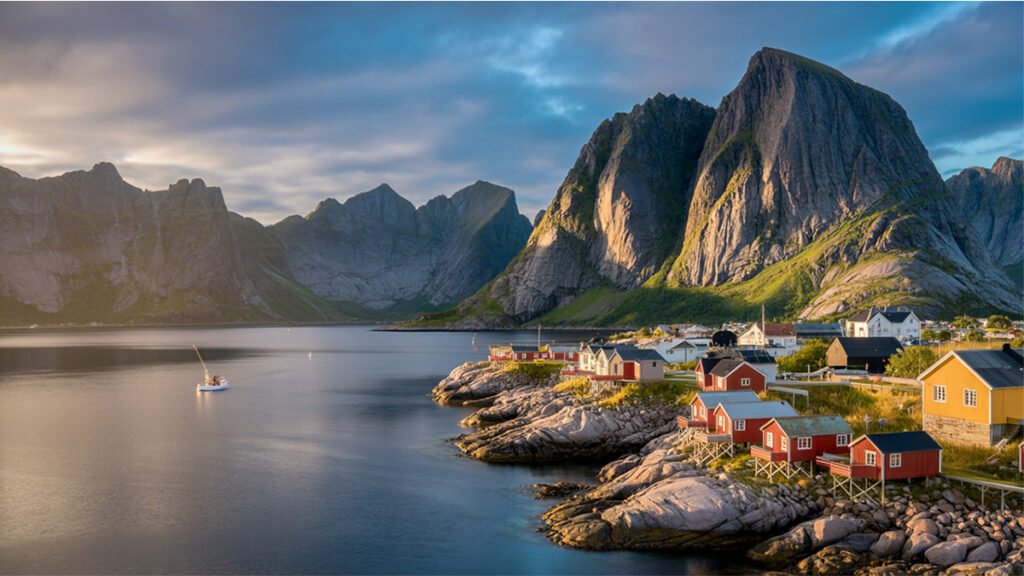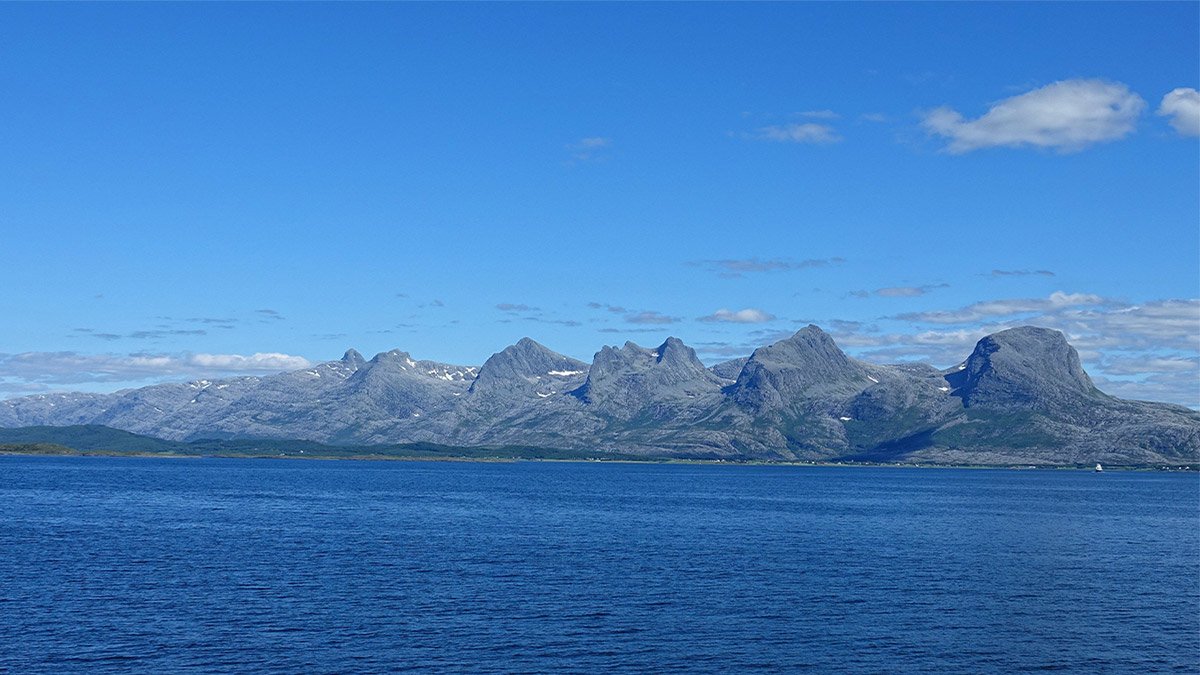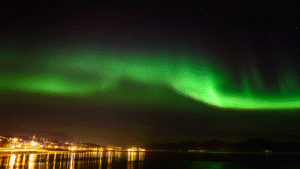Estimated reading time: 17 minutes
Key Takeaways
- The Lofoten Islands are characterized by dramatic mountains, pristine beaches, and picturesque fishing villages, making them a premier Norwegian destination.
- The best time to visit Lofoten is summer for the midnight sun and hiking, while winter offers northern lights viewing opportunities.
- The Saltstraumen maelstrom near Bodø is the world’s strongest tidal current, creating spectacular whirlpools up to 10 meters in diameter.
- A Trollfjord boat tour provides access to one of Norway’s most dramatic fjords, with steep mountain walls rising directly from the sea.
- Nordland offers diverse attractions beyond Lofoten, including historic villages, scenic drives, and cultural museums.
Table of Contents
- Introduction
- Discovering Northern Norway’s Natural Wonders
- The Lofoten Islands Travel Guide
- Midnight Sun in Tromsø Summer
- Saltstraumen Maelstrom Experience in Nordland
- Trollfjord Boat Tour in Nordland
- What to See in Nordland, Norway
- Conclusion
Introduction
Welcome to Northern Norway
Northern Norway stands as a region of breathtaking contrasts where jagged mountain peaks plunge dramatically into the Norwegian Sea. This Lofoten Islands travel guide will take you through a land where nature’s grandeur is on full display, from pristine arctic beaches to sheltered fishing villages nestled between towering cliffs. [SOURCE]
This remote northern paradise offers travelers unique experiences found nowhere else in Europe. You can explore the rugged beauty of the Lofoten archipelago, witness the magical phenomenon of the midnight sun in Tromsø during summer months, feel the raw power of the Saltstraumen maelstrom, and sail through the narrow passage of Trollfjord surrounded by steep mountain walls. [SOURCE]
Beyond these natural wonders, Nordland county boasts a rich cultural heritage, with fishing traditions dating back centuries and villages that seem frozen in time. From photographing red fishermen’s cabins against snow-capped peaks to hiking trails with panoramic fjord views, Northern Norway promises adventures that will stay with you long after you’ve returned home. [SOURCE]
Want to see this for yourself? Click here to jump to the video in UHD 4K Resolution.
Discovering Northern Norway’s Natural Wonders
Northern Norway captivates visitors with its unique blend of Arctic wilderness and deeply rooted coastal traditions. This region represents Norway at its most raw and authentic, where nature’s extremes create landscapes of startling beauty. [SOURCE]
The landscape features a striking combination of natural elements: sharp, jagged mountains that rise abruptly from the sea, deep crystal-clear fjords that cut into the mainland, surprisingly white-sand beaches that could be mistaken for tropical shores (if not for the Arctic temperatures), and small, colorful fishing communities that dot the coastline like living museums. [SOURCE]
What makes Northern Norway truly special is how these natural features interact with human elements. Here, Viking heritage still resonates in local stories and archaeological sites. The fishing industry, which has sustained communities for centuries, continues to thrive alongside modern tourism. Visitors can experience the wellness effects of natural phenomena like the midnight sun in summer and the northern lights in winter, creating a perfect blend of natural spectacle and cultural depth.
This remarkable region serves as an ideal foundation for immersive adventures—whether hiking rugged trails, driving along coastal roads with panoramic views, visiting small museums that preserve local traditions, or sampling robust local cuisine featuring the freshest seafood imaginable—all surrounded by some of the most photogenic scenery in the world.
The Lofoten Islands Travel Guide
The Lofoten Islands form an archipelago that seems almost otherworldly in its beauty. These islands feature rugged coastlines where waves crash against ancient rock formations, picturesque fishing villages with their characteristic red cabins (rorbuer), and dramatic alpine peaks that create a jagged silhouette against the sky. [SOURCE]
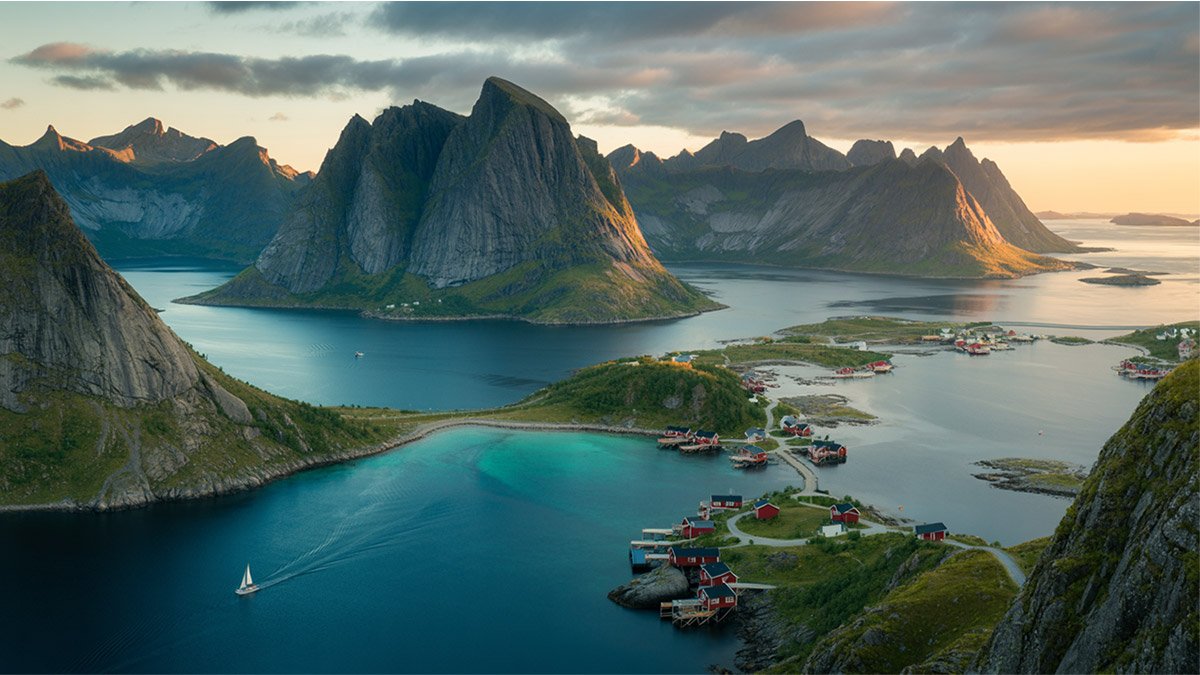
Spectacular Landscapes
The islands are renowned for their sharp mountain formations, with peaks like Reinebringen offering what many consider Norway’s most spectacular viewpoint. From its summit, hikers are rewarded with panoramic vistas of surrounding islands, sheltered bays, and the vast Norwegian Sea beyond. The archipelago also boasts tranquil fjords that slice between mountains, creating mirror-like reflections on calm days. [SOURCE]
Beaches like Kvalvika and Ramberg surprise visitors with their white sand and crystal-clear (though bracingly cold) waters. These Arctic beaches offer unique experiences—imagine strolling along pristine shores with snow-capped mountains as your backdrop. [SOURCE]
Charming Villages
Lofoten’s villages are attractions in themselves, each with unique character:
- Svolvær: The capital of Lofoten offers a perfect blend of urban amenities and access to natural wonders. It serves as a gateway for Trollfjord cruises and features art galleries, shops, and excellent dining options.
- Henningsvær: Often called “the Venice of Lofoten,” this village spreads across several small islands connected by bridges. Its combination of art galleries and classic Norwegian coastal architecture makes it especially popular with photographers.
- Reine: Possibly Norway’s most photographed village, Reine sits beneath towering peaks with its red and white fishermen’s cabins reflected in sheltered waters.
- Å: At the very end of the main road through Lofoten, this tiny settlement preserves traditional fishing methods and houses the fascinating Stockfish Museum.
When to Visit and What to Do
The best time to visit Lofoten depends on your interests. Summer (June-August) brings the midnight sun, providing endless daylight for hiking, photography, and outdoor activities. Winter (December-February) offers opportunities to witness the northern lights dancing above snow-covered landscapes and experience the cozy atmosphere of staying in a traditional fisherman’s cabin. [SOURCE]
For photography enthusiasts, the most photogenic spots include the village viewpoints at Reine and Hamnøy, the beaches at Uttakleiv (famous for its “eye” rock formation), and the panoramic vistas from mountain hikes like Reinebringen and Ryten.
Unique experiences in Lofoten include:
- Sea eagle safaris, where you can observe these magnificent birds hunting in their natural habitat
- Visiting the Lofotr Viking Museum in Borg to step back in time
- Surfing at Unstad Beach, one of the world’s northernmost surf spots
- Sampling local seafood specialties, particularly fresh cod during the winter fishing season
Midnight Sun in Tromsø Summer
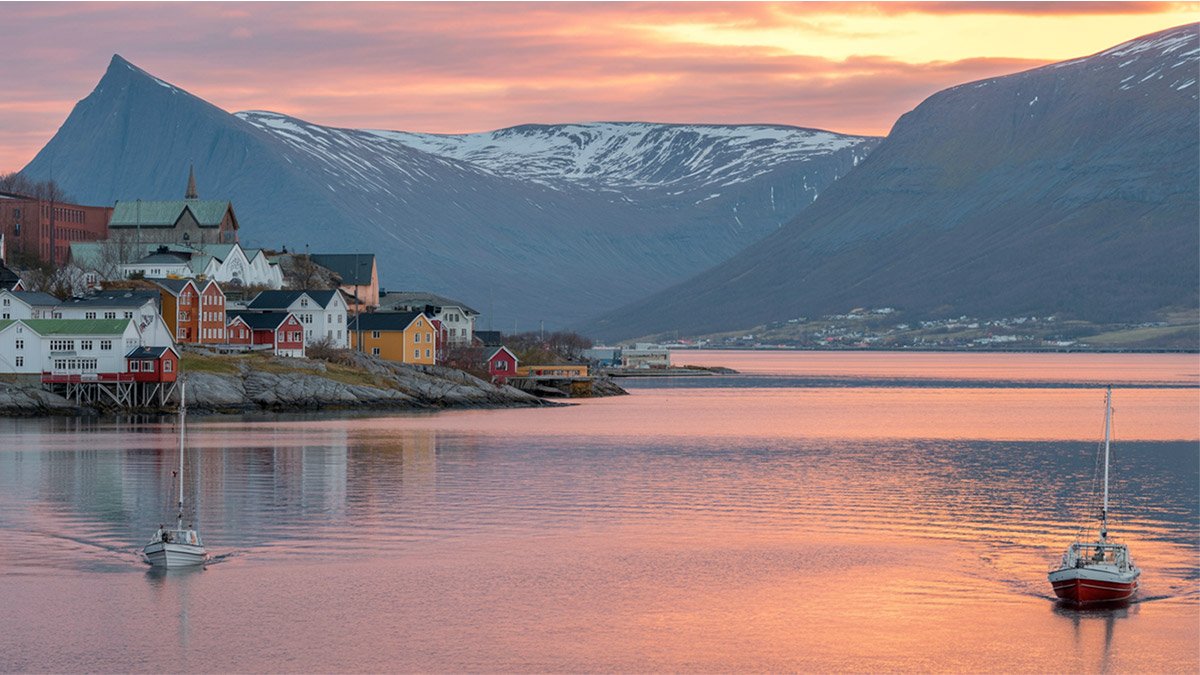
The midnight sun is a natural phenomenon that occurs north of the Arctic Circle where the sun remains visible for a continuous 24-hour period during summer months. In Tromsø, located at 69° north latitude, this magical experience transforms the city and surrounding landscapes from approximately late May through late July. [SOURCE]
Understanding the Phenomenon
During midnight sun season, the sun doesn’t set below the horizon, instead traveling in a circular path across the sky. This creates a unique golden light that bathes the landscape throughout the night hours, casting long shadows and giving photographers what professionals call the “golden hour” for extended periods. The phenomenon gradually intensifies as you travel farther north, with Svalbard experiencing continuous daylight for nearly four months.
Activities Under the Midnight Sun
The endless daylight transforms summer activities in Tromsø by removing time constraints. Visitors can enjoy:
- Midnight hiking on nearby mountains like Storsteinen, accessible via the Fjellheisen cable car, offering panoramic views of Tromsø island bathed in golden light
- Kayaking in the calm waters of the fjords at “night,” when the water often becomes mirror-like
- Midnight golfing at the world’s northernmost 18-hole golf course
- Cultural events and festivals that take advantage of the extended daylight, including outdoor concerts and the famous Midnight Sun Marathon
Photography Tips Under Continuous Daylight
Photographing under the midnight sun presents unique opportunities and challenges:
- The low-angle golden light creates dramatic shadows and highlights that add depth to landscape photographs
- The fjords and mountains surrounding Tromsø reflect this light beautifully, especially from elevated viewpoints
- Bring a tripod despite the abundant light—the low angle can still require longer exposures for optimal results
- Look for silhouettes of people or landmarks against the bright sky for dramatic compositions
- Remember to pack eye masks for sleeping, as the constant daylight can disrupt your body’s natural rhythm
The midnight sun profoundly affects local culture and daily life in Tromsø. During these bright summer months, locals embrace the endless daylight with outdoor gatherings, midnight barbecues, and a general feeling of celebration after the long, dark winter. Visitors often report feeling energized by the constant light, making it easier to pack multiple activities into each day of their stay.
Saltstraumen Maelstrom Experience in Nordland
The Saltstraumen maelstrom is frequently described as the world’s strongest tidal current, creating a natural spectacle that has fascinated visitors for centuries. Located in a narrow, 3-kilometer-long strait connecting the Saltfjord and Skjerstadfjord near the city of Bodø in Nordland county, this powerful natural phenomenon demonstrates nature’s raw force in dramatic fashion. [SOURCE]

What Creates the Maelstrom?
The maelstrom forms when massive tidal shifts force up to 400 million cubic meters of seawater through the narrow strait every six hours. This tremendous volume of water, moving at speeds reaching 40 kilometers per hour, creates powerful whirlpools (vortices) that can reach up to 10 meters in diameter and 5 meters in depth. The collision of opposing currents generates these swirling formations, which appear and disappear in rhythmic patterns as the tide changes. [SOURCE]
Experiencing Saltstraumen Safely
There are several ways to witness this remarkable natural phenomenon:
- Boat tours: Local operators provide guided trips that bring you close to the whirlpools while maintaining a safe distance. These tours are led by experienced captains who understand the currents and plan their excursions around tide schedules for optimal viewing.
- Saltstraumen Bridge: The bridge spanning the strait offers excellent observation points for those who prefer to stay on land. From this elevated vantage point, visitors get sweeping views of the currents and whirlpools forming below.
- Shoreline viewpoints: Several marked areas along the shoreline allow visitors to observe the maelstrom from secure positions on land.
Timing Your Visit
The intensity of the Saltstraumen varies significantly based on the lunar cycle and resulting tides. For the most spectacular display:
- Consult local tide tables before planning your visit—the current is strongest approximately 2 hours after high tide in Bodø
- The phenomenon is most dramatic during new and full moons when tidal differences are greatest
- Spring and autumn often feature the strongest currents due to seasonal tidal variations
Beyond the visual spectacle, Saltstraumen is also known for its rich marine ecosystem. The strong currents bring nutrients that attract various fish species, making it a popular spot for anglers seeking cod, saithe, wolffish, and halibut. Some boat tours combine maelstrom viewing with fishing opportunities, offering a more interactive experience with this unique environment. [SOURCE]
Trollfjord Boat Tour in Nordland
The Trollfjord (Trollfjorden) stands as one of Norway’s most dramatic and imposing fjords, characterized by its extremely narrow entrance and towering, steep-sided mountain walls that rise dramatically from the sea. Located between the Lofoten and Vesterålen archipelagos in Nordland county, this 2-kilometer-long, 100-meter-wide fjord creates an almost mystical setting that seems to belong in Norse mythology. [SOURCE]
The Unique Appeal of Trollfjord
What makes Trollfjord particularly special is its striking physical characteristics:
- Sheer rock walls that rise vertically from the water to heights of up to 1,100 meters
- An extremely narrow entrance that makes it seem almost hidden until you’re directly upon it
- Crystal-clear, deep waters that reflect the surrounding mountains on calm days
- The play of light and shadow as sunlight filters between the high mountain walls
The fjord is only accessible by boat, which adds to its pristine, untouched quality. As vessels navigate the narrow entrance, passengers often feel a sense of awe as the towering cliffs seem to close in around them before the fjord opens slightly into its inner basin.
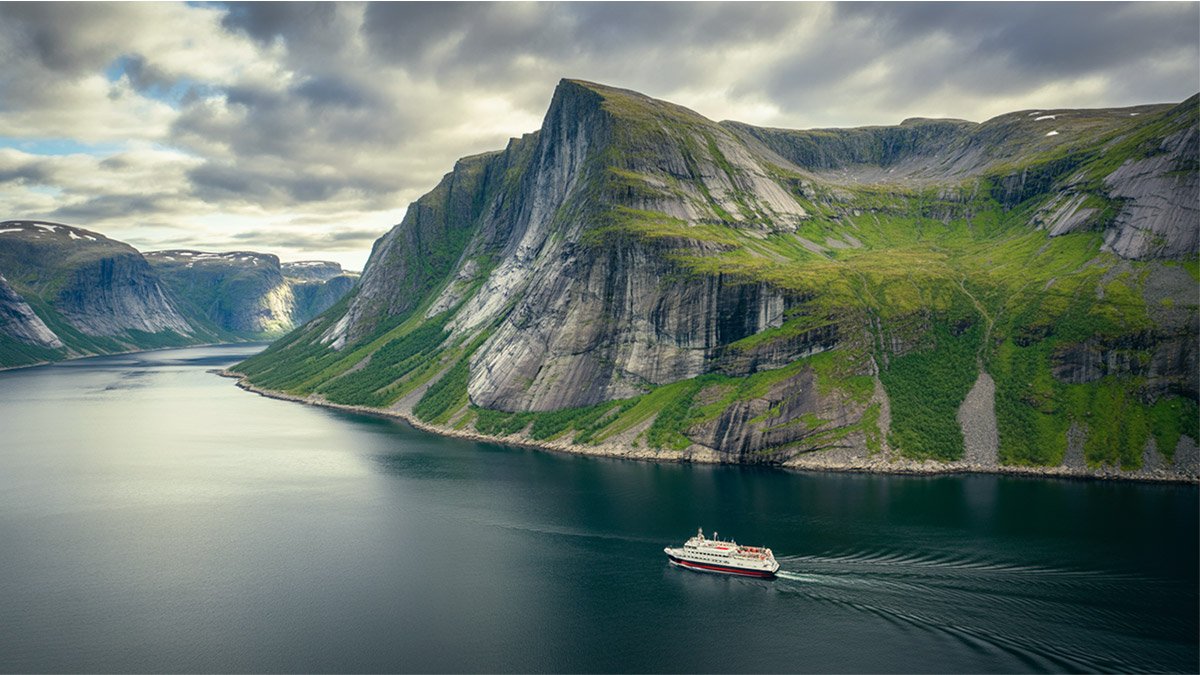
Boat Tour Experience
A Trollfjord boat tour offers the best—and only—way to experience this natural wonder:
- Tours typically depart from nearby ports like Svolvær, Stokmarknes, or other towns in the Lofoten and Vesterålen islands
- Many tour operators use smaller vessels that can navigate comfortably through the narrow fjord
- The journey often includes informative commentary about the fjord’s geology, history, and wildlife
- Some tours include opportunities to see sea eagles, which nest in the high cliffs surrounding the fjord
- More extended tours might include refreshments featuring local specialties like dried fish or locally brewed beverages
Choosing the Right Trollfjord Boat Tour
When selecting a Trollfjord boat tour, consider these factors:
- Boat size: Smaller boats can navigate closer to the cliffs and create a more intimate experience
- Tour duration: Options range from quick 2-hour visits to full-day excursions that include other nearby attractions
- Guide expertise: Look for tours led by locals who can share insights about the area’s natural and cultural history
- Environmental considerations: Some operators now offer silent, electric boats that reduce noise pollution and environmental impact
The best time to experience Trollfjord is during the summer months (June through August) when the weather is most stable, though spring and autumn visits offer fewer crowds and beautiful seasonal colors. Winter tours are less common but provide a dramatically different experience with snow-dusted mountains and the possibility of seeing the northern lights on return evening journeys.
What to See in Nordland, Norway
Beyond the already highlighted attractions of Trollfjord and Saltstraumen, Nordland county offers a wealth of diverse experiences that showcase Northern Norway’s rich natural and cultural heritage. This region stretches along Norway’s western coast, encompassing the dramatic mountains, fjords, and islands that make this part of the country so distinctive. [SOURCE]
Scenic Routes and Natural Wonders
Nordland features some of Norway’s most spectacular driving routes:
- The E10 Highway through Lofoten provides what many consider Norway’s most scenic drive, winding between mountains and crossing bridges that connect the archipelago’s islands
- The Helgeland Coast National Tourist Route showcases the southern part of Nordland, with its characteristic archipelago landscape of thousands of islands and skerries
- The Seven Sisters Mountain Range (De Syv Søstre) near Sandnessjøen presents a dramatic silhouette of seven distinct peaks along the Helgeland coast
- Svartisen Glacier, Norway’s second-largest glacier, offers accessible hiking routes to view its blue ice formations
Cultural Attractions and Historic Sites
Nordland’s rich cultural heritage is preserved in its museums, historic sites, and living traditions:
- The Lofotr Viking Museum in Borg features a reconstructed longhouse and artifacts from the area’s Viking past
- The Kjerringøy Trading Post near Bodø preserves a 19th-century merchant’s estate, offering insights into coastal trading history
- The Norwegian Fishing Village Museum in Å documents the traditional fishing lifestyle that has sustained communities for centuries
- The Nordland Music Festival in Bodø celebrates classical and contemporary music each August
Charming Villages and Towns in Nordland
Throughout Nordland, small communities offer authentic glimpses into coastal Norwegian life:
- Bodø, the regional capital, serves as a gateway to the region with its modern culture scene and proximity to natural attractions
- Nyksund in Vesterålen has transformed from an abandoned fishing village to an artists’ community with galleries and studios
- Nusfjord represents one of Norway’s oldest and best-preserved fishing villages, with its historic buildings now serving as museums and accommodation
- Mosjøen features Sjøgata, a street of preserved 19th-century wooden houses that create a living museum of traditional architecture
Suggested Multi-Day Itinerary in Nordland Norway
To experience Nordland’s highlights, consider this five-day itinerary:
- Day 1: Arrive in Bodø, visit the Saltstraumen maelstrom, and explore the city’s cultural attractions
- Day 2: Take the ferry to Moskenes in Lofoten, drive to Reine, and hike Reinebringen for panoramic views
- Day 3: Explore western Lofoten, visiting the villages of Å and Nusfjord, and the beaches at Ramberg
- Day 4: Drive east through Lofoten, stopping at Henningsvær, then continue to Svolvær for a Trollfjord boat tour
- Day 5: Return to Bodø via ferry, or continue north to Vesterålen and Tromsø if time permits
This region offers excellent opportunities for outdoor activities throughout the year, including Northern Lights viewing in winter, midnight sun experiences in summer, world-class fishing in spring and autumn, and fjord tours in all seasons. [SOURCE]
Frequently Asked Questions about Northern Norway’s Natural Wonders
When is the best time to experience the midnight sun and northern lights in Northern Norway?
The optimal time to see the midnight sun is during summer, roughly from late May through late July, when the sun doesn’t set north of the Arctic Circle. In contrast, northern lights are most visible in the darker months, typically between September and early April, with the best chances occurring on clear nights away from city lights.
How can I include both the Saltstraumen maelstrom and Trollfjord in a multi-day itinerary?
You can start in Bodø to experience the powerful tides and whirlpools of the Saltstraumen. Then take a ferry to Lofoten for dramatic landscapes and arrange a boat tour from Svolvær or nearby to cruise into the narrow, majestic Trollfjord—often with wildlife sightings like sea eagles along the way.
What should I pack and prepare for when visiting Northern Norway’s natural landscapes?
Pack layered, weather-resistant clothing suitable for unpredictable Arctic weather—waterproof outer layers, thermal base layers, and solid walking shoes. A tripod and camera gear will help capture the dramatic light during the midnight sun season, while for winter trips include warm essentials and perhaps eye masks to rest during long daylight hours.
Are there any safety considerations when visiting natural attractions like Saltstraumen or hiking in Lofoten?
Yes. At Saltstraumen, strong currents and whirlpools reach up to 10 meters in diameter—keep a safe distance, or join guided boat tours timed with tides. In Lofoten, trails can be rugged; always check weather and trail conditions, start hikes early, and use maps or local guidance to ensure safety.
How budget-friendly is touring Northern Norway, and are there ways to save on costs?
Northern Norway can be expensive, especially during peak summer. To save, consider visiting in spring or autumn when prices are lower and crowds fewer, yet weather still favorable. Self-driving along scenic routes like the E10 or Helgeland Coast can offer flexibility and cost savings over organized bus tours.
Conclusion
Northern Norway presents a landscape of extraordinary beauty and diversity that captivates all who visit. From the jagged mountain peaks and sheltered bays of the Lofoten Islands to the mesmerizing swirl of the Saltstraumen maelstrom, this region offers natural wonders that seem almost otherworldly in their grandeur.
The experiences highlighted in this guide—exploring Lofoten’s picturesque fishing villages, witnessing the magical midnight sun in Tromsø, feeling the raw power of Saltstraumen, and sailing through the narrow passage of Trollfjord—each provide a unique window into what makes Northern Norway so special. These attractions showcase both the dramatic landscapes and the deep cultural connections that have shaped life in this remote Arctic region for centuries.
When planning your Norwegian adventure, consider how these diverse experiences might fit into your itinerary. Perhaps begin with the cultural richness of the Lofoten Islands before venturing to witness natural phenomena like the midnight sun or maelstrom. The proximity of these attractions within Nordland county makes it possible to experience several in a single trip, though each deserves time for proper appreciation.
Northern Norway rewards those who approach it with patience and openness. The weather can be unpredictable, and distances between attractions sometimes substantial, but these challenges are far outweighed by the rewards of experiencing some of Europe’s most pristine and dramatic landscapes.
We invite you to share your own Northern Norway experiences or questions in the comments below. And for more stunning travel documentaries showcasing the world’s most beautiful destinations, visit Pathfinders Travel on YouTube to watch more wonders of the world in stunning 4K resolution.

